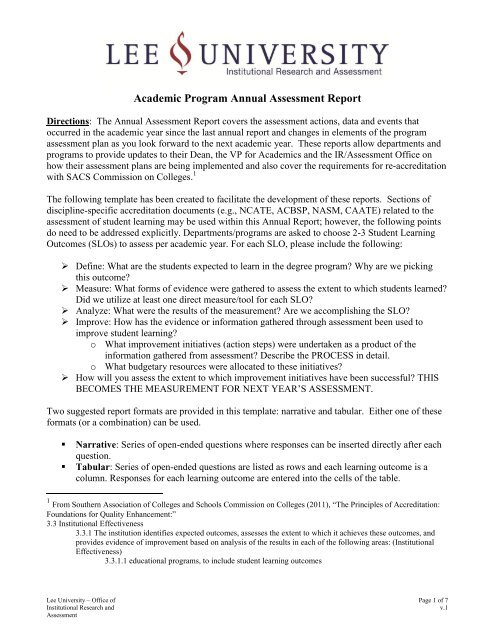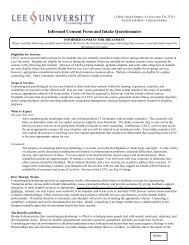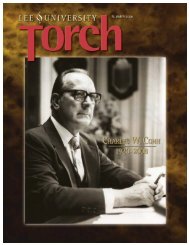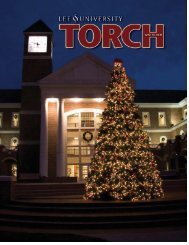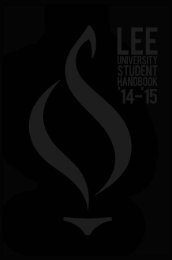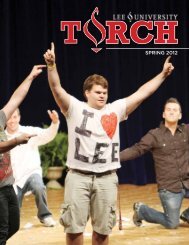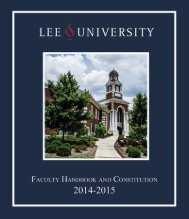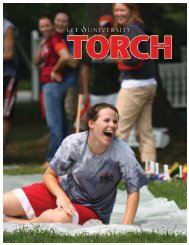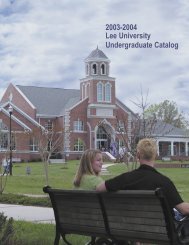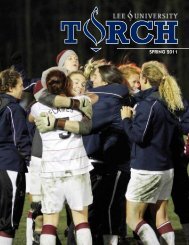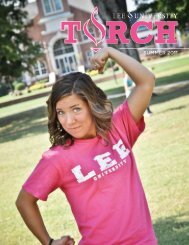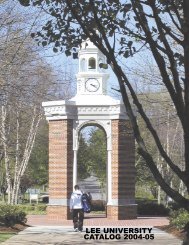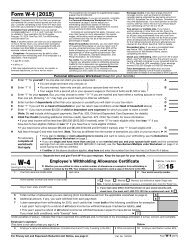Academic Assessment Report Template - Lee University
Academic Assessment Report Template - Lee University
Academic Assessment Report Template - Lee University
You also want an ePaper? Increase the reach of your titles
YUMPU automatically turns print PDFs into web optimized ePapers that Google loves.
<strong>Academic</strong> Program Annual <strong>Assessment</strong> <strong>Report</strong><br />
Directions: The Annual <strong>Assessment</strong> <strong>Report</strong> covers the assessment actions, data and events that<br />
occurred in the academic year since the last annual report and changes in elements of the program<br />
assessment plan as you look forward to the next academic year. These reports allow departments and<br />
programs to provide updates to their Dean, the VP for <strong>Academic</strong>s and the IR/<strong>Assessment</strong> Office on<br />
how their assessment plans are being implemented and also cover the requirements for re-accreditation<br />
with SACS Commission on Colleges. 1<br />
The following template has been created to facilitate the development of these reports. Sections of<br />
discipline-specific accreditation documents (e.g., NCATE, ACBSP, NASM, CAATE) related to the<br />
assessment of student learning may be used within this Annual <strong>Report</strong>; however, the following points<br />
do need to be addressed explicitly. Departments/programs are asked to choose 2-3 Student Learning<br />
Outcomes (SLOs) to assess per academic year. For each SLO, please include the following:<br />
‣ Define: What are the students expected to learn in the degree program? Why are we picking<br />
this outcome?<br />
‣ Measure: What forms of evidence were gathered to assess the extent to which students learned?<br />
Did we utilize at least one direct measure/tool for each SLO?<br />
‣ Analyze: What were the results of the measurement? Are we accomplishing the SLO?<br />
‣ Improve: How has the evidence or information gathered through assessment been used to<br />
improve student learning?<br />
o What improvement initiatives (action steps) were undertaken as a product of the<br />
information gathered from assessment? Describe the PROCESS in detail.<br />
o What budgetary resources were allocated to these initiatives?<br />
‣ How will you assess the extent to which improvement initiatives have been successful? THIS<br />
BECOMES THE MEASUREMENT FOR NEXT YEAR’S ASSESSMENT.<br />
Two suggested report formats are provided in this template: narrative and tabular. Either one of these<br />
formats (or a combination) can be used.<br />
• Narrative: Series of open-ended questions where responses can be inserted directly after each<br />
question.<br />
• Tabular: Series of open-ended questions are listed as rows and each learning outcome is a<br />
column. Responses for each learning outcome are entered into the cells of the table.<br />
1 From Southern Association of Colleges and Schools Commission on Colleges (2011), “The Principles of Accreditation:<br />
Foundations for Quality Enhancement:”<br />
3.3 Institutional Effectiveness<br />
3.3.1 The institution identifies expected outcomes, assesses the extent to which it achieves these outcomes, and<br />
provides evidence of improvement based on analysis of the results in each of the following areas: (Institutional<br />
Effectiveness)<br />
3.3.1.1 educational programs, to include student learning outcomes<br />
<strong>Lee</strong> <strong>University</strong> – Office of<br />
Institutional Research and<br />
<strong>Assessment</strong><br />
Page 1 of 7<br />
v.1
Narrative Format<br />
<strong>Academic</strong> year: (enter most recently completed aca yr., e.g. 2011-2012)<br />
Department/Program:<br />
Degree program(s):<br />
Person(s) preparing report:<br />
Date submitted:<br />
1. List the student learning outcomes (SLOs) that were assessed during the academic year,<br />
including those for which data were gathered as well as those for which developmental work<br />
was done, such as the piloting of assessment measures. Describe why these were chosen.<br />
2. For each learning outcome, describe a) the measures used (at least one direct measure 2 must be<br />
used for each SLO), b) the sample of students from whom data were collected, c) the timetable<br />
for the collection, and d) the setting in which the measures were administered.<br />
3. Describe the results of the assessment. (What do they tell you about student learning in general<br />
and mastery of measured SLOs in particular? What did you learn about strengths and<br />
weaknesses of your program?)<br />
4. Describe the departmental process by which faculty reviewed the assessment procedures and<br />
results and decided on the actions and/or revisions that were needed.<br />
5. Describe the actions and/or revisions that were implemented in response to the assessment<br />
processes and results. Describe the process in detail. Be sure to include budgetary resources<br />
that were allocated to these actions/initiatives.<br />
6. Given the assessment activities and results to date, describe your assessment plans for the<br />
next academic year. Will you continue to assess the same SLO? Which new SLOs will you<br />
choose to assess? Why?<br />
2 Direct measures include: Comprehensive exams, writing proficiency exams, national exams assessing subject matter<br />
knowledge, such as MFT), certification or licensure exams, locally developed pre-test/post-test for mastery of knowledge,<br />
performance assessment [rubric] for graduating seniors (i.e., recitals, art exhibits, science projects, etc.), senior thesis or<br />
major project [rubric], portfolio evaluation [rubric] containing representative examples of students’ work.<br />
Indirect measures include:<br />
Peer institution comparisons, employer surveys, graduate school acceptance rates, graduate school performance, student<br />
graduation/retention rates, exit interviews, student course evaluations, internship evaluations, focus group discussions,<br />
alumni surveys (both satisfaction and achievement), curriculum analysis.<br />
<strong>Lee</strong> <strong>University</strong> – Office of<br />
Institutional Research and<br />
<strong>Assessment</strong><br />
Page 2 of 7<br />
v.1
Tabular Format<br />
<strong>Academic</strong> year: (enter most recently completed aca yr., e.g. 2011-2012)<br />
Department/Program:<br />
Degree program(s):<br />
Person(s) preparing report:<br />
Date submitted:<br />
Objectives to be Addressed<br />
1. List the student learning outcomes<br />
(SLOs) that were assessed during<br />
the academic year, including those<br />
for which data were gathered as<br />
well as those for which<br />
developmental work was done, such<br />
as the piloting of assessment<br />
measures. Describe why these were<br />
chosen.<br />
2. For each learning outcome, describe<br />
a) the measures used (at least one<br />
direct measure 3 must be used for<br />
each SLO), b) the sample of<br />
students from whom data were<br />
collected, c) the timetable for the<br />
collection, and d) the setting in<br />
which the measures were<br />
administered.<br />
3. Describe the results of the<br />
assessment. (What do they tell you<br />
about student learning in general<br />
and mastery of measured SLOs in<br />
particular? What did you learn<br />
about strengths and weaknesses of<br />
your program?)<br />
SLO(s) Assessed in the <strong>Academic</strong> Year<br />
1. 2. 3.<br />
3 Direct measures include: Comprehensive exams, writing proficiency exams, national exams assessing subject matter<br />
knowledge, such as MFT), certification or licensure exams, locally developed pre-test/post-test for mastery of knowledge,<br />
performance assessment [rubric] for graduating seniors (i.e., recitals, art exhibits, science projects, etc.), senior thesis or<br />
major project [rubric], portfolio evaluation [rubric] containing representative examples of students’ work.<br />
Indirect measures include:<br />
Peer institution comparisons, employer surveys, graduate school acceptance rates, graduate school performance, student<br />
graduation/retention rates, exit interviews, student course evaluations, internship evaluations, focus group discussions,<br />
alumni surveys (both satisfaction and achievement), curriculum analysis.<br />
<strong>Lee</strong> <strong>University</strong> – Office of<br />
Institutional Research and<br />
<strong>Assessment</strong><br />
Page 3 of 7<br />
v.1
4. Describe the departmental process<br />
by which faculty reviewed the<br />
assessment procedures and results<br />
and decided on the actions and/or<br />
revisions that were needed.<br />
5. Describe the actions and/or<br />
revisions that were implemented in<br />
response to the assessment<br />
processes and results. Describe the<br />
process in detail. Be sure to include<br />
budgetary resources that were<br />
allocated to these actions/initiatives.<br />
6. Given the assessment activities and<br />
results to date, describe your<br />
assessment plans for the next<br />
academic year. Will you continue<br />
to assess the same SLO? Which<br />
new SLOs will you choose to<br />
assess? Why?<br />
<strong>Lee</strong> <strong>University</strong> – Office of<br />
Institutional Research and<br />
<strong>Assessment</strong><br />
Page 4 of 7<br />
v.1
Evaluative Rubric for Annual <strong>Assessment</strong> <strong>Report</strong>s<br />
<strong>Assessment</strong> Outcomes<br />
Pre-<strong>Report</strong><br />
Departments will…<br />
Identify institutional goals that pertain<br />
to the goals/objectives of the<br />
Department.<br />
Develop a list of 4-10 Student Learning<br />
Outcomes (SLOs) for each degree<br />
program.<br />
ANNUAL REPORT<br />
Departments will…<br />
Exemplary<br />
3<br />
Identified all applicable<br />
institutional goals (2 or<br />
more).<br />
SLOs were stated in<br />
terms of measurable<br />
knowledge, behavior,<br />
value, or disposition.<br />
Acceptable<br />
2<br />
Identified one pertinent<br />
institutional goal.<br />
Not all of the SLOs were<br />
stated in measurable terms.<br />
Unacceptable<br />
1<br />
No institutional goals<br />
identified.<br />
No SLOs were listed.<br />
(Or too many were<br />
listed – more than 10.)<br />
Score<br />
for each<br />
Element<br />
Annually select 2-3 Student Learning<br />
Outcomes (SLOSs) from their<br />
programmatic list to assess.<br />
2-3 SLOs selected from<br />
programmatic list.<br />
One SLO identified from<br />
programmatic list OR 2-3<br />
SLOs listed, but not pulled<br />
from programmatic list.<br />
No SLOs identified.<br />
Identify and discuss at least one direct<br />
assessment method/measure for each<br />
SLO.<br />
At least one direct<br />
measure was used,<br />
identified, and<br />
discussed for each<br />
SLO, including<br />
participants involved<br />
for each measure and<br />
setting and timeframe<br />
in which measures<br />
were administered.<br />
At least one direct measure<br />
was used and identified, but<br />
was not adequately<br />
discussed.<br />
Measures were not<br />
used or developed OR<br />
only indirect measures<br />
were used.<br />
<strong>Lee</strong> <strong>University</strong> – Office of<br />
Institutional Research and<br />
<strong>Assessment</strong><br />
Page 5 of 7<br />
v1
Describe the results for each measure.<br />
Results were described<br />
for each measurement<br />
of each SLO that was<br />
assessed.<br />
Results were described for a<br />
sub-set of the SLOs assessed<br />
or results were given but not<br />
described.<br />
Results were not<br />
described for the<br />
SLOs that were to be<br />
assessed.<br />
Describe the actions or revisions<br />
implemented based on assessment<br />
results.<br />
Specific actions or<br />
revisions implemented<br />
based on assessment<br />
results, including<br />
budgetary allocations,<br />
were described.<br />
Specific actions or revisions<br />
were suggested but the report<br />
on implementation was<br />
incomplete or unclear.<br />
There were no specific<br />
actions or revisions<br />
described.<br />
Describe plans for the coming<br />
academic year, including any<br />
significant changes to degree program<br />
SLOs or to the general assessment<br />
strategy.<br />
Plans for the coming<br />
year and any<br />
significant changes in<br />
SLOs or the overall<br />
assessment strategy<br />
are clearly described.<br />
Plans and any significant<br />
changes were described but<br />
in some aspects the<br />
description was unclear or<br />
incomplete.<br />
There was no<br />
description of plans for<br />
the coming year nor<br />
were any significant<br />
changes in SLOs or<br />
assessment strategy<br />
described.<br />
<strong>Lee</strong> <strong>University</strong> – Office of<br />
Institutional Research and<br />
<strong>Assessment</strong><br />
Page 6 of 7<br />
v1
Feedback on Annual <strong>Report</strong> from the<br />
Office of Institutional Research and <strong>Assessment</strong><br />
Degree Program: _______________________________<br />
Date:____________<br />
Department: ____________________ College:___________________________<br />
<strong>Report</strong> (most recently completed aca yr.) status: approved /revise and resubmit<br />
Strengths of report and progress on assessment loop:<br />
Guiding Questions<br />
1. Assesses student learning?<br />
Were SLOs identified & measured?<br />
Process/methodology lead to clear data<br />
on target SLO(s)?<br />
2. Clearly leads to Improvement?<br />
Did process lead to improvement<br />
conversations?<br />
Was the improvement carried out &<br />
measured?<br />
3. Make sense?<br />
Doable/Sustainable?<br />
Do pieces align?<br />
Concerns/Questions:<br />
Suggestions for future reports or assessment approaches:<br />
Other comments:<br />
<strong>Lee</strong> <strong>University</strong> – Office of<br />
Institutional Research and<br />
<strong>Assessment</strong><br />
Page 7 of 7<br />
v1


